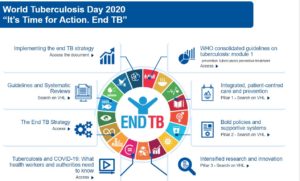World Tuberculosis Day is celebrated every year on March 24th to raise public awareness of the devastating health, social, and economic consequences of this disease and to intensify efforts to end a global epidemic. The date marks the day in 1882, when Robert Koch announced the discovery of the bacteria that causes tuberculosis, which paved the way for the diagnosis and cure of the disease.
 Under the theme “It’s time for action. End TB”, it is expected to urgently accelerate a response to the disease to save lives and reduce its impact worldwide. The campaign originated from the commitment of Heads of State at the United Nations High-Level Meeting on tuberculosis[1] in 2018.
Under the theme “It’s time for action. End TB”, it is expected to urgently accelerate a response to the disease to save lives and reduce its impact worldwide. The campaign originated from the commitment of Heads of State at the United Nations High-Level Meeting on tuberculosis[1] in 2018.
The World Health Organization is advising Member States on the importance of ensuring that the prevalent health services continue to protect the lives of people with tuberculosis during the COVID-19 pandemic, since these patients are more susceptible to lung illnesses than healthy individuals[2].
Window of Knowledge on World Tuberculosis Day
In order to gather relevant and updated information on tuberculosis, BIREME/PAHO/WHO developed a Window of Knowledge, focusing on the theme of World Tuberculosis Day 2020: “It’s time to act. End TB”. The Window provides direct access to reference documents such as plans, strategies, and guidelines for combating and controlling the disease and provides filters for scientific publications in the VHL, with the theme of the three pillars of The End TB Strategy. These are: 1. Integrated and patient-centered care and prevention; 2. Bold policies and supportive systems; 3. Intensified research and innovation.
In this way, BIREME promotes the access and use of quality scientific and technical information on tuberculosis for researchers, health professionals, students, public policy creators, and society, with the objective of diagnosing early, treating and eliminating tuberculosis.
Tuberculosis is an infectious disease caused by a bacterium (Mycobacterium tuberculosis) that mainly affects the lungs. It can remain asymptomatic for some time in relatively healthy people, but even at this stage it is transmissible to others, through airborne droplets of secretions. Treatment consists of a course of antibiotics for at least six months. The main symptoms include cough, sometimes with bleeding, weight loss, weakness, fever, and night sweats.
Despite being a disease with relatively simple treatment and does not require hospitalization in the early stages, tuberculosis still infects 10 million people worldwide (in 2018) and causes 1.5 million deaths. Of these, 251,000 were also infected with HIV. In the Americas, 289,000 cases were diagnosed in the same year, with 22,900 deaths and 5,900 (26%) cases of HIV co-infection, as a result of the low immunity caused by the virus. There still exist 11,000 cases of antibiotic-resistant tuberculosis in the Americas.
The strategy to eliminate tuberculosis created in 2014, which follows the criteria of the Agenda 2030[3] Sustainable Development Goals, has as its main goal to end the global tuberculosis epidemic. The strategy emphasizes milestones for reducing deaths from infection by 95%, reducing new cases by 90% between 2015 and 2035 and ensures that no family faces catastrophic costs due to tuberculosis.
[1] UN General Assembly High-Level Meeting on the fight against tuberculosis. The World Health Organization. Available at: https://www.who.int/news-room/events/un-general-assembly-high-level-meeting-on-ending-tb
[2] Tuberculosis and COVID-19: What health workers and authorities need to know. Pan American Health Organization. Available at: https://www.paho.org/hq/index.php?option=com_content&view=article&id=15759:tuberculosis-and-covid-19-what-health-workers-and-authorities-need-to-know&catid=740&lang=en&Itemid=1926
[3] Item 3.3 of Goal 3 – Health and Well-Being. “By 2030 end the epidemics of AIDS, tuberculosis, malaria, and neglected tropical diseases and combat hepatitis, water-borne diseases, and other communicable diseases”. Source: https://sustainabledevelopment.un.org/
